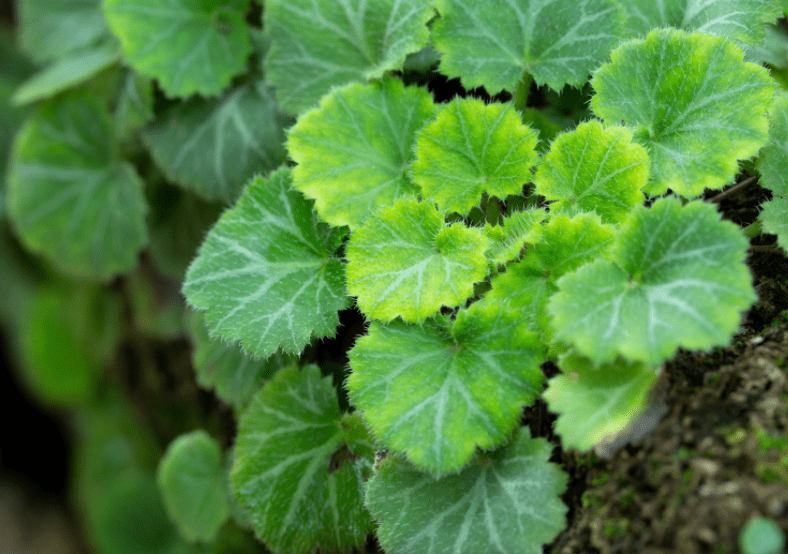Strawberry Begonia
Despite its common names, strawberry begonia (Saxifraga stolonifera) is neither a strawberry, a begonia, nor a geranium. It represents the Saxifrage family and has relatives such as Astilbe, foamflowers (Tiarella), and alumroot (Heuchera).
Strawberry begonia plants have 2- to 4-inch roundish to heart-shaped leaves. Distinctive, silvery veins decorate the tops of the leaves, and reddish, hairy undersides lend an extra dimension that is delightful to touch.
Strawberry Begonia Propagating
Plants spread by sending out runners in the manner of strawberries. Lacy clusters of pink or white flowers bloom from spring to fall. Beautiful foliage and the ability to spread rapidly make it a good groundcover.
This hardworking groundcover prefers shade or part shade. Soil should be humidity retentive but thoroughly drained. Plant along paths under trees or other protective structures where its exciting texture and color can be best appreciated.
Very little maintenance is needed to keep strawberry begonia growing well. Flowers can be removed after they die, and some edging may be necessary to keep them in bounds.
In the northern distances of its hardiness range, strawberry begonia dies back to the roots in winter, but it is evergreen in most of Zones 8-10.
Several cultivars of Saxifraga stolonifera (syn. S. sarmentosa) are available. Tricolor has striking foliage of hot pink, deep raspberry, white and dark green. Kinki Purple’ has rounded, purple-backed leaves covered in long red hair.
Clumps send out foot-long bright red threads that drop to the ground and sprout new plants where they land.
Harvest Moon’ has brilliant sulfur-yellow foliage with a red, metallic sheen. Some nurseries also list Athens’ and Maroon Beauty’.
Strawberry begonia has long been a favorite hanging basket plant. It can be tucked in cracks in walls or between pavers or rocks.
How To Grow Strawberry Begonia
Since I have learned of its hardiness, my favorite way to grow it is as a groundcover under the grapefruit tree in my backyard.
Get your start of strawberry begonia from local nurseries, or find a friend who grows it. Collect a few seeds and sow them in a moist, sandy planting medium, or be sure to visit when your friend is dividing the plants.
Easier still, pull off a few trailing rosettes and root them for your garden. It may be just the plant you’re seeking to cover the ground in a shady place in your yard.
Optimal Conditions
Strawberry begonia plants are simple to grow and care for, making them ideal for inexperienced houseplant owners. They dislike excessive humidity and warmth, which can promote fungal growth, and are prone to root rot if overwatered.
They are also more resistant to cold than most people believe. and can survive temperatures as low as 45 degrees Fahrenheit and still recover.
For the best results, repot your plant every spring, as they don’t like being pot-bound and will not grow to look their best. Keep in mind that growth may slow or stop during the winter.
Light
Strawberry begonias prefer bright, but not direct sunlight. Generally, east or west-facing window is ideal. Allowing your plant to receive direct sunlight can cause it to burn and cause holes in its leaves.
Strawberry begonia plants thrive in lightweight, fast-draining potting soil. It should be moist but not drenched.
Water
These plants grow quickly and require a lot of water during their growing season. To reduce the risk of fungal diseases, avoid getting water on the leaves of your strawberry begonia, as you would with other hairy-leaved plants.
Once two or three inches of soil have dried out, water your plant and soak it until you notice water dripping out of the drainage holes in the base.
Reduce your watering frequency during the winter, but don’t let your plant completely dry out.
Humidity and temperature
Strawberry begonia plants prefer cool temperatures over hot ones; for your plant to thrive, try to keep a temperature range of 50 to 75 degrees Fahrenheit in its surroundings.
Your plant will not thrive in hot weather, so relocate your begonia to a cooler location. Strawberry begonia plants can thrive in moderate to high humidity levels, but most average levels in the home do not need to be increased.
Fertilizer
Feed weekly with a weak liquid fertilizer that contains micronutrients during the growing season and promotes blooming. Controlled release fertilizer pellets are also highly effective.
Begonia Strawberry Pie
- 3 cups begonia stems (leaves and flowers removed)
- 1 cup sliced strawberries
- Four tablespoons cornstarch
- 1 1/4 cups granulated sugar
- Pinch salt
- Two tablespoons unsalted butter
- One 9-inch unbaked pie crust
- Petals from 1 or 2 begonia blossoms
- Several strawberries halved
- 1 pint heavy cream, whipped stiff
Preparation
- Cut begonia stems into 1/2-inch pieces and combines with the sliced strawberries; set aside.
- In a second bowl, mix the cornstarch with the sugar and salt. Add this to the begonia-strawberry mixture and blend gently.
- Discharge into the pie shell and bake at 425-degrees for 10 minutes.
- Reduce heat to 350 degrees and bake for 25 to 30 minutes, or until the crust is golden brown.
- Cool 15 minutes before serving.
- Garnish each slice with begonia petals and strawberry halves.
- Serve with a dollop of blended cream on the side.
- Serves 6.


























